 Technology peripherals
Technology peripherals
 AI
AI
 A review of the development of the CLIP model, the cornerstone of Vincentian diagrams
A review of the development of the CLIP model, the cornerstone of Vincentian diagrams
A review of the development of the CLIP model, the cornerstone of Vincentian diagrams
CLIP stands for Contrastive Language-Image Pre-training, which is a pre-training method or model based on contrastive text-image pairs. It is a multimodal model that relies on contrastive learning. The training data for CLIP consists of text-image pairs, where an image is paired with its corresponding text description. Through contrastive learning, the model aims to understand the relationship between text and image pairs.

Open AI released DALL-E and CLIP in January 2021. Both models are multi-modal models that can combine images and text. DALL-E is a model that generates images based on text, while CLIP uses text as a supervision signal to train a transferable visual model.
In the Stable Diffusion model, the text features extracted by the CLIP text encoder are embedded into the UNet of the diffusion model through cross attention. Specifically, text features are used as the key and value of attention, while UNet features are used as query. In other words, CLIP is actually a key bridge between text and pictures, organically combining text information and image information. This combination enables the model to better understand and process information between different modalities, thereby achieving better results when handling complex tasks. In this way, the Stable Diffusion model can more effectively utilize the text encoding capabilities of CLIP, thereby improving overall performance and expanding application areas.
CLIP

This is the earliest paper published by OpenAI in 2021. If you want to understand CLIP, We need to deconstruct the acronym into its three components: (1) Contrastive, (2) Language-Image, (3) Pre-training.
Let’s start with Language-Image.
In traditional machine learning models, usually only a single modality of input data can be accepted, such as text, images, tabular data or audio. If you need to use different modalities of data to make predictions, you must train multiple different models. In CLIP, "Language-Image" means that the model can accept both text (language) and image input data. This design enables CLIP to process information of different modalities more flexibly, thus improving its predictive capabilities and application scope.
CLIP handles text and image input by using two different encoders, a text encoder and an image encoder. These two encoders map the input data into a lower-dimensional latent space, generating corresponding embedding vectors for each input. An important detail is that the text and image encoders embed the data into the same space, i.e. the original CLIP space is a 512-dimensional vector space. This design enables direct comparison and matching between text and images without additional conversion or processing. In this way, CLIP can represent text descriptions and image content in the same vector space, thereby enabling cross-modal semantic alignment and retrieval functions. The design of this shared embedding space gives CLIP better generalization capabilities and adaptability, allowing it to perform well on a variety of tasks and datasets.
Contrastive
While embedding text and image data into the same vector space may be a useful starting point, simply doing this does not There is no guarantee that the model can effectively compare representations of text and images. For example, it is important to establish a reasonable and interpretable relationship between the embedding of “dog” or “a picture of a dog” in a text and the embedding of a dog image. However, we need a way to bridge the gap between these two models.
In multimodal machine learning, there are various techniques to align two modalities, but currently the most popular method is contrast. Contrastive techniques take pairs of inputs from two modalities: say an image and its caption and train the model's two encoders to represent these input data pairs as closely as possible. At the same time, the model is incentivized to take unpaired inputs (such as images of dogs and the text "pictures of cars") and represent them as far away as possible. CLIP is not the first contrastive learning technique for images and text, but its simplicity and effectiveness have made it a mainstay in multimodal applications.
Pre-training
Although CLIP itself is useful for tasks such as zero-shot classification, semantic search, and unsupervised data exploration, etc. Applications are useful, but CLIP is also used as a building block for a host of multimodal applications, from Stable Diffusion and DALL-E to StyleCLIP and OWL-ViT. For most of these downstream applications, the initial CLIP model is considered the starting point for "pre-training" and the entire model is fine-tuned for its new use case.
While OpenAI never explicitly specified or shared the data used to train the original CLIP model, the CLIP paper mentioned that the model was performed on 400 million image-text pairs collected from the Internet. trained.
https://www.php.cn/link/7c1bbdaebec5e20e91db1fe61221228f
ALIGN: Scaling Up Visual and Vision -Language Representation Learning With Noisy Text Supervision
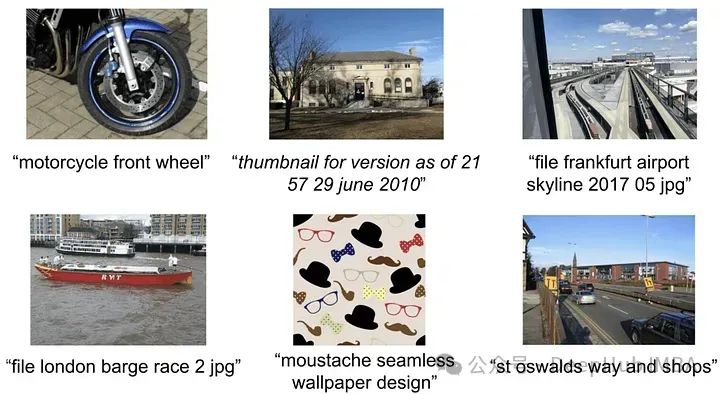
Using CLIP, OpenAI uses 400 million image-text pairs, because no details are provided, so we don’t Probably knows exactly how to build the dataset. But in describing the new dataset, they looked to Google's Conceptual Captions as inspiration - a relatively small dataset (3.3 million image-caption pairs) that uses expensive filtering and post-processing techniques, although these The technology is powerful, but not particularly scalable).
So high-quality data sets have become the direction of research. Shortly after CLIP, ALIGN solved this problem through scale filtering. ALIGN does not rely on small, carefully annotated, and curated image captioning datasets, but instead leverages 1.8 billion pairs of images and alt text.
While these alt text descriptions are much noisier on average than the titles, the sheer size of the dataset more than makes up for this. The authors used basic filtering to remove duplicates, images with over 1,000 relevant alt text, as well as uninformative alt text (either too common or containing rare tags). With these simple steps, ALIGN reaches or exceeds the state-of-the-art on various zero-shot and fine-tuning tasks.
https://arxiv.org/abs/2102.05918
K-LITE: Learning Transferable Visual Models with External Knowledge
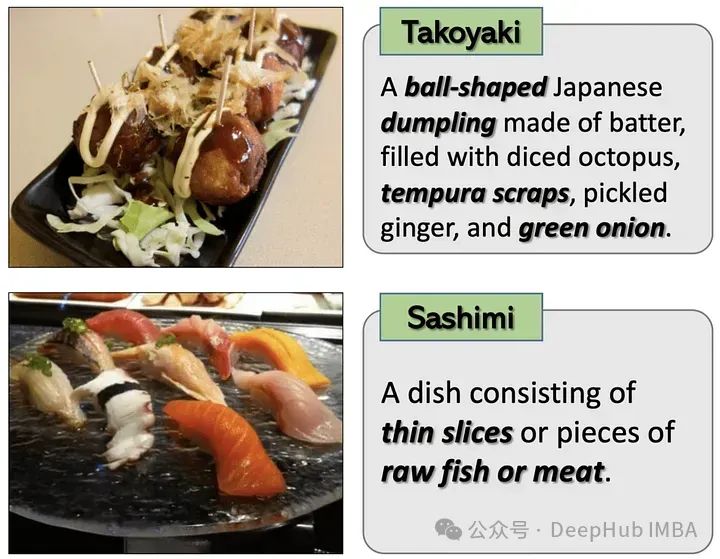
Like ALIGN, K-LITE is also solving problems for Comparing the problem of limited number of pre-trained high-quality image-text pairs.
K-LITE focuses on explaining concepts, i.e. definitions or descriptions as context and unknown concepts can help develop broad understanding. A popular explanation is that when people first introduce technical terms and uncommon vocabulary, they usually simply define them! Or use an analogy to something everyone knows.
To implement this approach, researchers from Microsoft and the University of California, Berkeley, used WordNet and Wiktionary to enhance the text in image-text pairs. For some isolated concepts, such as class labels in ImageNet, the concepts themselves are enhanced, while for titles (e.g. from GCC), the least common noun phrases are enhanced. With this additional structured knowledge, pre-trained models show substantial improvements on transfer learning tasks.
https://arxiv.org/abs/2204.09222
OpenCLIP: Reproducible scaling laws for contrastive language-image learning
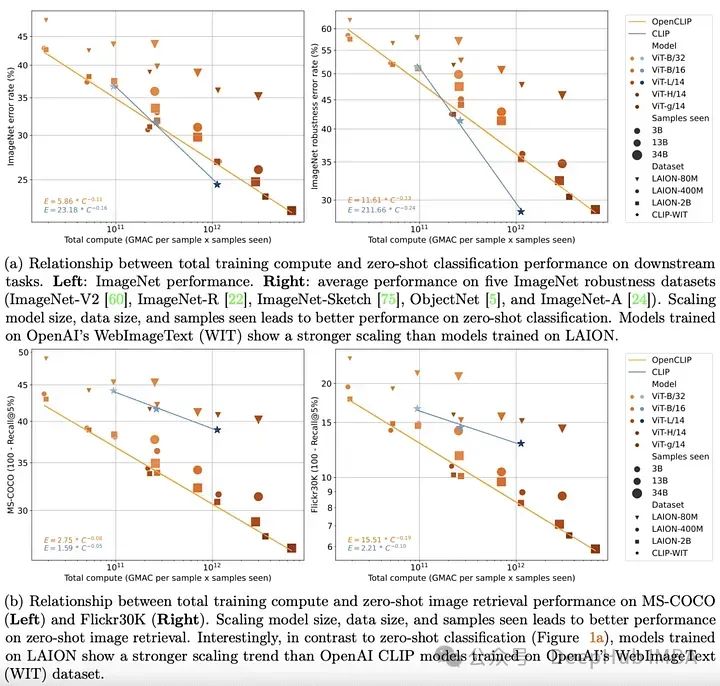
By the end of 2022, the transformer model has been established in the text and visual fields. Pioneering empirical work in both fields has also clearly shown that the performance of transformer models on unimodal tasks can be well described by simple scaling laws. This means that as the amount of training data, training time, or model size increases, one can predict the performance of the model fairly accurately.
OpenCLIP extends the above theory to multi-modal scenarios by using the largest open source image-text pair dataset released to date (5B), systematically studying the performance of training data pair models. Impact on performance in zero-shot and fine-tuning tasks. As in the unimodal case, this study reveals that model performance on multimodal tasks scales with a power law in terms of computation, number of samples seen, and number of model parameters.
Even more interesting than the existence of power laws is the relationship between power law scaling and pre-training data. Retaining OpenAI's CLIP model architecture and training method, the OpenCLIP model shows stronger scaling capabilities on sample image retrieval tasks. For zero-shot image classification on ImageNet, OpenAI’s model (trained on its proprietary dataset) demonstrated stronger scaling capabilities. These findings highlight the importance of data collection and filtering procedures on downstream performance.
https://arxiv.org/abs/2212.07143However, shortly after OpenCLIP was released, the LAION data set was removed from the Internet because it contained illegal images.
MetaCLIP: Demystifying CLIP Data
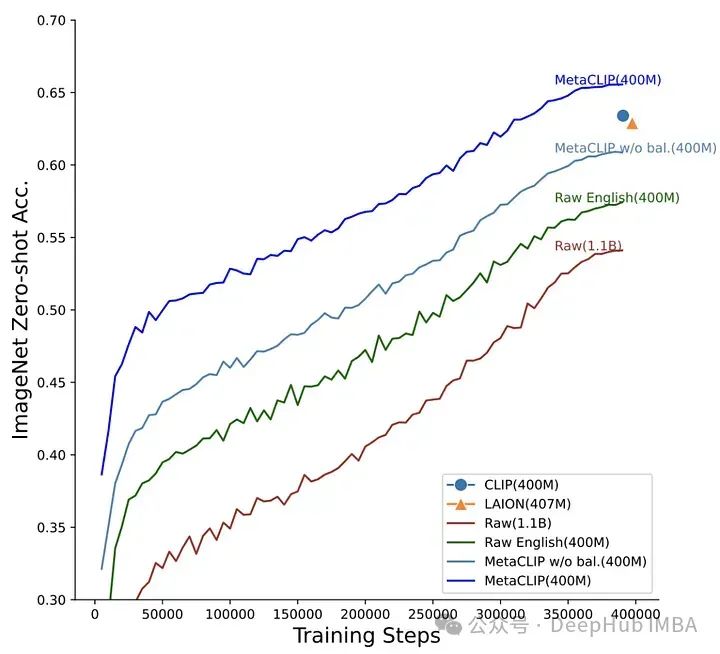
OpenCLIP attempts to understand how the performance of downstream tasks scales with data volume, The amount of calculation and the number of model parameters vary, while MetaCLIP focuses on how to select data. As the authors say, "We believe that the main factor in CLIP's success is its data, rather than the model architecture or pre-training goals."
In order to verify this hypothesis, the author fixed the model architecture and training steps and conducted experiments. The MetaCLIP team tested a variety of strategies related to substring matching, filtering, and balancing data distribution, and found that the best performance was achieved when each text appeared a maximum of 20,000 times in the training data set. To test this theory, they would even The word "photo", which occurred 54 million times in the initial data pool, was also limited to 20,000 image-text pairs in the training data. Using this strategy, MetaCLIP was trained on 400M image-text pairs from the Common Crawl dataset, outperforming OpenAI’s CLIP model on various benchmarks.
https://arxiv.org/abs/2309.16671
DFN: Data Filtering Networks
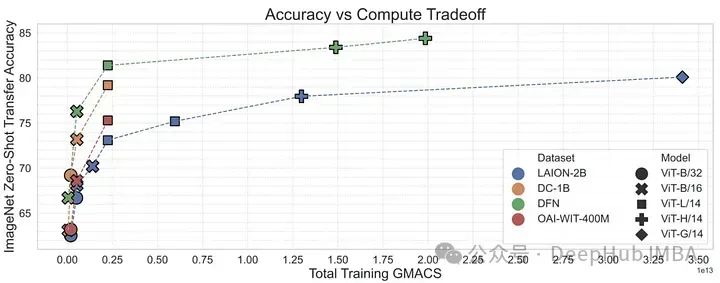
With the research on MetaCLIP, it can be shown that data management may be the most important factor in training high-performance multi-modal models such as CLIP. MetaCLIP's filtering strategy is very successful, but it is also mainly based on heuristic methods. The researchers then turned to whether a model could be trained to do this filtering more efficiently.
To verify this, the author uses high-quality data from the conceptual 12M to train the CLIP model to filter high-quality data from low-quality data. This Data Filtering Network (DFN) is used to build a larger high-quality dataset by selecting only high-quality data from an uncurated dataset (in this case Common Crawl). CLIP models trained on filtered data outperformed models trained only on initial high-quality data and models trained on large amounts of unfiltered data.
https://arxiv.org/abs/2309.17425
Summary
OpenAI’s CLIP model has significantly changed The way we deal with multimodal data. But CLIP is just the beginning. From pre-training data to the details of training methods and contrastive loss functions, the CLIP family has made incredible progress over the past few years. ALIGN scales noisy text, K-LITE enhances external knowledge, OpenCLIP studies scaling laws, MetaCLIP optimizes data management, and DFN enhances data quality. These models deepen our understanding of the role of CLIP in the development of multimodal artificial intelligence, demonstrating progress in connecting images and text.
The above is the detailed content of A review of the development of the CLIP model, the cornerstone of Vincentian diagrams. For more information, please follow other related articles on the PHP Chinese website!

Hot AI Tools

Undresser.AI Undress
AI-powered app for creating realistic nude photos

AI Clothes Remover
Online AI tool for removing clothes from photos.

Undress AI Tool
Undress images for free

Clothoff.io
AI clothes remover

Video Face Swap
Swap faces in any video effortlessly with our completely free AI face swap tool!

Hot Article

Hot Tools

Notepad++7.3.1
Easy-to-use and free code editor

SublimeText3 Chinese version
Chinese version, very easy to use

Zend Studio 13.0.1
Powerful PHP integrated development environment

Dreamweaver CS6
Visual web development tools

SublimeText3 Mac version
God-level code editing software (SublimeText3)

Hot Topics
 1387
1387
 52
52
 Bytedance Cutting launches SVIP super membership: 499 yuan for continuous annual subscription, providing a variety of AI functions
Jun 28, 2024 am 03:51 AM
Bytedance Cutting launches SVIP super membership: 499 yuan for continuous annual subscription, providing a variety of AI functions
Jun 28, 2024 am 03:51 AM
This site reported on June 27 that Jianying is a video editing software developed by FaceMeng Technology, a subsidiary of ByteDance. It relies on the Douyin platform and basically produces short video content for users of the platform. It is compatible with iOS, Android, and Windows. , MacOS and other operating systems. Jianying officially announced the upgrade of its membership system and launched a new SVIP, which includes a variety of AI black technologies, such as intelligent translation, intelligent highlighting, intelligent packaging, digital human synthesis, etc. In terms of price, the monthly fee for clipping SVIP is 79 yuan, the annual fee is 599 yuan (note on this site: equivalent to 49.9 yuan per month), the continuous monthly subscription is 59 yuan per month, and the continuous annual subscription is 499 yuan per year (equivalent to 41.6 yuan per month) . In addition, the cut official also stated that in order to improve the user experience, those who have subscribed to the original VIP
 Context-augmented AI coding assistant using Rag and Sem-Rag
Jun 10, 2024 am 11:08 AM
Context-augmented AI coding assistant using Rag and Sem-Rag
Jun 10, 2024 am 11:08 AM
Improve developer productivity, efficiency, and accuracy by incorporating retrieval-enhanced generation and semantic memory into AI coding assistants. Translated from EnhancingAICodingAssistantswithContextUsingRAGandSEM-RAG, author JanakiramMSV. While basic AI programming assistants are naturally helpful, they often fail to provide the most relevant and correct code suggestions because they rely on a general understanding of the software language and the most common patterns of writing software. The code generated by these coding assistants is suitable for solving the problems they are responsible for solving, but often does not conform to the coding standards, conventions and styles of the individual teams. This often results in suggestions that need to be modified or refined in order for the code to be accepted into the application
 Can fine-tuning really allow LLM to learn new things: introducing new knowledge may make the model produce more hallucinations
Jun 11, 2024 pm 03:57 PM
Can fine-tuning really allow LLM to learn new things: introducing new knowledge may make the model produce more hallucinations
Jun 11, 2024 pm 03:57 PM
Large Language Models (LLMs) are trained on huge text databases, where they acquire large amounts of real-world knowledge. This knowledge is embedded into their parameters and can then be used when needed. The knowledge of these models is "reified" at the end of training. At the end of pre-training, the model actually stops learning. Align or fine-tune the model to learn how to leverage this knowledge and respond more naturally to user questions. But sometimes model knowledge is not enough, and although the model can access external content through RAG, it is considered beneficial to adapt the model to new domains through fine-tuning. This fine-tuning is performed using input from human annotators or other LLM creations, where the model encounters additional real-world knowledge and integrates it
 Seven Cool GenAI & LLM Technical Interview Questions
Jun 07, 2024 am 10:06 AM
Seven Cool GenAI & LLM Technical Interview Questions
Jun 07, 2024 am 10:06 AM
To learn more about AIGC, please visit: 51CTOAI.x Community https://www.51cto.com/aigc/Translator|Jingyan Reviewer|Chonglou is different from the traditional question bank that can be seen everywhere on the Internet. These questions It requires thinking outside the box. Large Language Models (LLMs) are increasingly important in the fields of data science, generative artificial intelligence (GenAI), and artificial intelligence. These complex algorithms enhance human skills and drive efficiency and innovation in many industries, becoming the key for companies to remain competitive. LLM has a wide range of applications. It can be used in fields such as natural language processing, text generation, speech recognition and recommendation systems. By learning from large amounts of data, LLM is able to generate text
 Five schools of machine learning you don't know about
Jun 05, 2024 pm 08:51 PM
Five schools of machine learning you don't know about
Jun 05, 2024 pm 08:51 PM
Machine learning is an important branch of artificial intelligence that gives computers the ability to learn from data and improve their capabilities without being explicitly programmed. Machine learning has a wide range of applications in various fields, from image recognition and natural language processing to recommendation systems and fraud detection, and it is changing the way we live. There are many different methods and theories in the field of machine learning, among which the five most influential methods are called the "Five Schools of Machine Learning". The five major schools are the symbolic school, the connectionist school, the evolutionary school, the Bayesian school and the analogy school. 1. Symbolism, also known as symbolism, emphasizes the use of symbols for logical reasoning and expression of knowledge. This school of thought believes that learning is a process of reverse deduction, through existing
 To provide a new scientific and complex question answering benchmark and evaluation system for large models, UNSW, Argonne, University of Chicago and other institutions jointly launched the SciQAG framework
Jul 25, 2024 am 06:42 AM
To provide a new scientific and complex question answering benchmark and evaluation system for large models, UNSW, Argonne, University of Chicago and other institutions jointly launched the SciQAG framework
Jul 25, 2024 am 06:42 AM
Editor |ScienceAI Question Answering (QA) data set plays a vital role in promoting natural language processing (NLP) research. High-quality QA data sets can not only be used to fine-tune models, but also effectively evaluate the capabilities of large language models (LLM), especially the ability to understand and reason about scientific knowledge. Although there are currently many scientific QA data sets covering medicine, chemistry, biology and other fields, these data sets still have some shortcomings. First, the data form is relatively simple, most of which are multiple-choice questions. They are easy to evaluate, but limit the model's answer selection range and cannot fully test the model's ability to answer scientific questions. In contrast, open-ended Q&A
 SOTA performance, Xiamen multi-modal protein-ligand affinity prediction AI method, combines molecular surface information for the first time
Jul 17, 2024 pm 06:37 PM
SOTA performance, Xiamen multi-modal protein-ligand affinity prediction AI method, combines molecular surface information for the first time
Jul 17, 2024 pm 06:37 PM
Editor | KX In the field of drug research and development, accurately and effectively predicting the binding affinity of proteins and ligands is crucial for drug screening and optimization. However, current studies do not take into account the important role of molecular surface information in protein-ligand interactions. Based on this, researchers from Xiamen University proposed a novel multi-modal feature extraction (MFE) framework, which for the first time combines information on protein surface, 3D structure and sequence, and uses a cross-attention mechanism to compare different modalities. feature alignment. Experimental results demonstrate that this method achieves state-of-the-art performance in predicting protein-ligand binding affinities. Furthermore, ablation studies demonstrate the effectiveness and necessity of protein surface information and multimodal feature alignment within this framework. Related research begins with "S
 SK Hynix will display new AI-related products on August 6: 12-layer HBM3E, 321-high NAND, etc.
Aug 01, 2024 pm 09:40 PM
SK Hynix will display new AI-related products on August 6: 12-layer HBM3E, 321-high NAND, etc.
Aug 01, 2024 pm 09:40 PM
According to news from this site on August 1, SK Hynix released a blog post today (August 1), announcing that it will attend the Global Semiconductor Memory Summit FMS2024 to be held in Santa Clara, California, USA from August 6 to 8, showcasing many new technologies. generation product. Introduction to the Future Memory and Storage Summit (FutureMemoryandStorage), formerly the Flash Memory Summit (FlashMemorySummit) mainly for NAND suppliers, in the context of increasing attention to artificial intelligence technology, this year was renamed the Future Memory and Storage Summit (FutureMemoryandStorage) to invite DRAM and storage vendors and many more players. New product SK hynix launched last year



